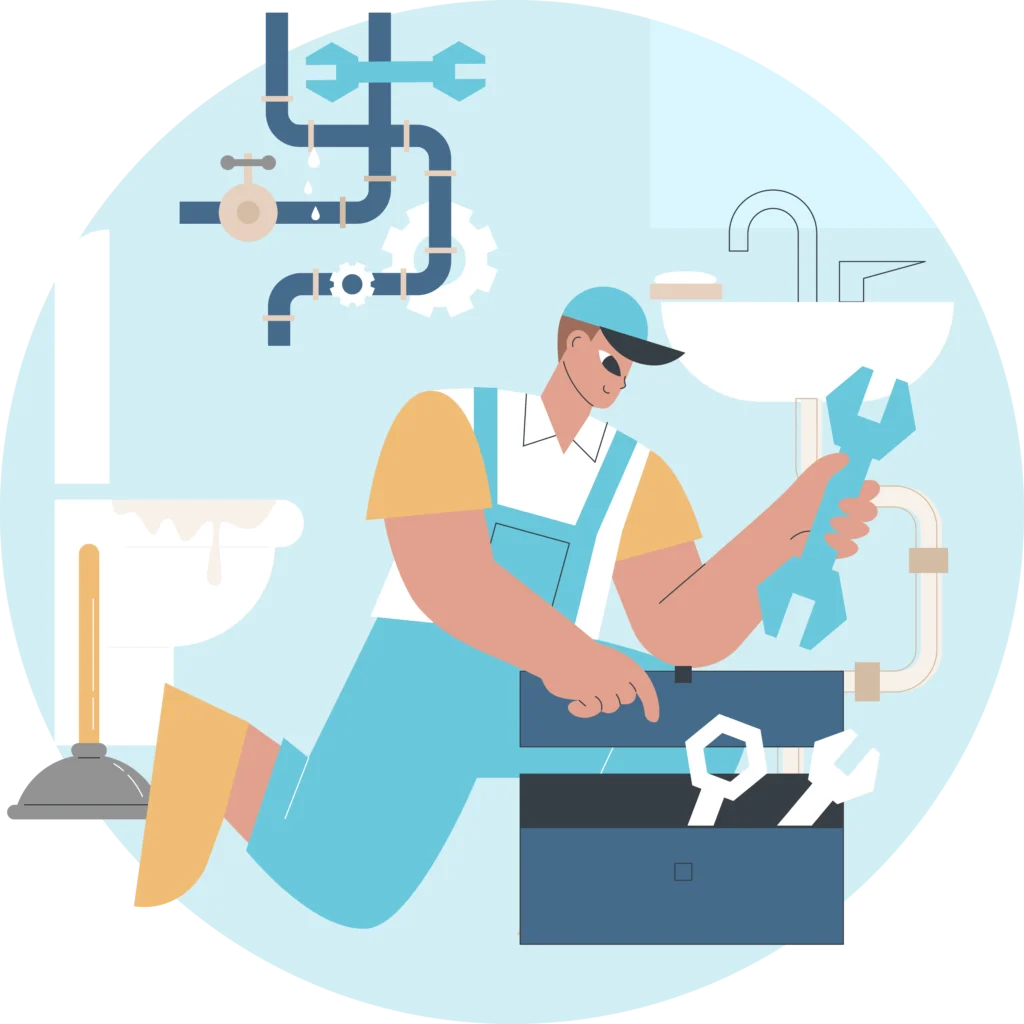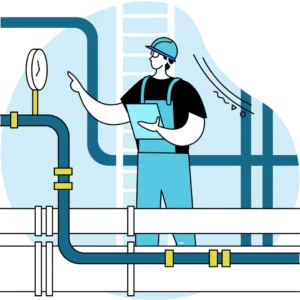When a pipe bursts or the toilet won’t stop running, most homeowners don’t flip through the Yellow Pages anymore; they pull out their phone and search “plumber near me.” In fact, 97% of people use search engines to find local services, and nearly 78% of local mobile searches lead to an offline purchase within 24 hours (Google/Ipsos).
That means if your plumbing business isn’t showing up on Google, you’re leaving money and customers on the table.
This is where local SEO for plumbers (also called SEO for plumbers) makes all the difference.
By optimizing your online presence, you can climb local rankings, stand out from competitors, and get more phone calls when customers need you most.
In this guide, we’ll walk you through 5 proven local SEO strategies for plumbers that will help you:
- Rank higher on Google in your service area
- Build trust with customer reviews
- Generate more calls and booked jobs
Let’s dive in.
Free Discovery Call
Ready to Grow Your Business?
Let’s turn your vision into reality. Book a free consultation and discover how Macro Digital can help you scale.
1. Optimize Your Google Business Profile (GBP)
If there’s one thing that can make or break your visibility as a plumber, it’s your Google Business Profile (GBP).
This is what shows up on Google Maps and the “local pack” (the top three businesses Google displays for searches like “plumber near me”).
According to BrightLocal, 68% of consumers would not consider a business with incorrect information online which makes your GBP accuracy critical.
Claim and Verify Your Listing
If you haven’t already, claim your GBP listing and verify it with Google. This is the foundation of your local SEO presence.
Add Complete NAP and Services
Make sure your Name, Address, and Phone number (NAP) are correct and consistent with your website.
List all your plumbing services (e.g., drain cleaning, water heater repair, emergency plumbing) so customers know exactly what you offer.
Upload Before-and-After Photos
Plumbing is a visual trade. Upload photos of your work like before-and-after shots of a clogged drain or a new bathroom installation.
Businesses with photos get 42% more requests for directions and 35% more click-throughs to their websites (Google).
Post Updates and Promotions
Keep your GBP active with weekly updates.
Share seasonal plumbing tips, discounts, or promotions.
Google rewards active profiles, and customers see you as engaged and trustworthy.
2. Get More Customer Reviews and Respond to Them
For plumbers, trust is everything.
When someone’s dealing with a flooded basement or a leaking pipe, they want reassurance that the person they call is reliable.
That’s why customer reviews are one of the most powerful ranking and conversion factors in local SEO.
In fact, 87% of consumers read online reviews before hiring a local service, and businesses with a higher average rating earn 54% more leads than those with lower ratings (BrightLocal).
Ask Every Customer for a Review
Don’t leave reviews to chance. After finishing a job, politely ask satisfied customers to leave you a review on Google.
You can even provide a short link or QR code that takes them directly to your review page.
Automate Review Requests
Use simple automation tools or your invoicing software to send follow-up emails and text reminders.
A quick “Thanks for trusting us today, would you mind sharing your experience?” can dramatically increase your review count.
Respond to All Reviews (Even Negative Ones)
Reply to every review. Thank customers for positive feedback and address negative ones with professionalism.
This not only shows future customers that you care, but it also signals to Google that your business is active and trustworthy.
Pro Tip: Encourage customers to mention specific services (like “emergency drain repair in Toronto”) in their reviews. Those keywords can help you rank better for those terms.
3. Target Local Plumbing Keywords on Your Website
One of the core principles of SEO for plumbers is making sure your website targets the exact local plumbing keywords customers are searching for.
Your website is more than just an online business card; it’s one of the strongest tools you have for capturing local search traffic.
By targeting the right local plumbing keywords, you can rank for the exact services customers are searching for in your area.
According to HubSpot, 75% of users never scroll past the first page of search results, so if your plumbing business isn’t showing up there, you’re practically invisible.
Create Location-Specific Service Pages
Don’t just list “plumbing services” on one page. Create dedicated pages for each service (e.g., “Drain Cleaning in Calgary” or “Emergency Plumber in Toronto”). This gives Google more opportunities to rank you for different local searches.
Use City + Service Combinations
People rarely search just “plumber.” They type “plumber in [city]” or “24/7 emergency plumber near me.”
These searches reflect local search intent, meaning the customer is ready to hire someone nearby. Optimize your title tags, H1s, and page content with these city + service combinations.
Add Local FAQs
Include a Frequently Asked Questions section that targets “near me” and city-specific queries.
Example: “How much does a plumber cost in Toronto?” or “Do you offer same-day plumbing in Calgary?” These FAQs can help you rank for voice searches and featured snippets.
Optimize On-Page SEO Elements
Ensure your title tags, meta descriptions, headers, and image alt text include relevant keywords naturally.
Following an on-page SEO checklist helps make sure you don’t miss any of these small but important details.
This not only helps rankings but also boosts click-through rates when customers see your listing in Google search results.
4. Build Local Citations and Backlinks
Google wants to see consistent proof that your plumbing business exists, serves a local area, and is trusted by the community.
That’s where citations and backlinks come in.
A citation is any online mention of your business name, address, and phone number (NAP).
A backlink is when another website links to yours.
Both are critical for local SEO because they reinforce your business’s legitimacy.
Submit to Local Directories
List your plumbing business on trusted directories like Yelp, HomeStars, Angie’s List, Houzz, and Yellow Pages.
Make sure your NAP is consistent across all platforms even small differences (like “Street” vs. “St.”) can confuse Google.
Get Featured on Local Blogs and News Sites
Pitch local bloggers, community websites, or news outlets to cover your services or offer a plumbing tip column.
Not only will this drive local traffic, but it also builds high-quality backlinks that boost your authority.
Partner with Local Businesses
Team up with HVAC companies, electricians, or home renovation contractors in your area.
You can trade website links, co-author content, or run promotions together.
These partnerships strengthen your local online footprint and credibility.
These tactics don’t just work for plumbing companies; they’re also a cornerstone of local SEO for franchise businesses that need consistent NAP across multiple locations.
Pro Tip: Aim for backlinks from sites with strong local relevance even a neighborhood association website can carry weight for Google’s local algorithm.
5. Use Local Content Marketing to Build Authority
Once your Google Business Profile, reviews, and citations are in place, content marketing becomes the engine that keeps driving new customers to your plumbing business.
Creating helpful, locally relevant content positions you as the go-to plumber in your area.
According to Demand Metric, content marketing generates 3x more leads than paid ads at 62% less cost.
For plumbers, this means you can attract customers before they even pick up the phone.
Publish Blogs That Solve Local Plumbing Problems
Write blog posts that address issues people in your service area face. Examples:
- “How to Prevent Frozen Pipes in Calgary Winters”
- “Average Cost of Drain Cleaning in Toronto”
- “Why You Shouldn’t Ignore Low Water Pressure in [City] Homes”
These posts naturally target long-tail keywords and answer real customer questions.
Add Videos and How-To Guides
Short videos showing quick fixes (like unclogging a sink) not only build trust but also increase engagement.
Even better is to upload them to YouTube, optimize for local keywords, and link back to your website.
Share Content on Local Channels
Don’t just publish and forget. Share your blogs and videos in local Facebook groups, community forums, or through neighborhood associations.
This spreads your content, earns backlinks, and keeps your business top-of-mind locally.
Pro Tip: Use a mix of seasonal content (frozen pipes, spring flooding, etc.) and evergreen topics (leak detection, water heater maintenance) to stay relevant all year round.
Conclusion
Local SEO isn’t just a buzzword, it’s the key to making sure your plumbing business gets found when customers in your area need you most.
By optimizing your Google Business Profile, building a steady flow of customer reviews, targeting local plumbing keywords, creating consistent citations and backlinks, and investing in content marketing, you can stay ahead of competitors and keep your phone ringing.
The best part? These strategies don’t require a massive budget, just consistency and a bit of effort each week.
Start by improving one area, like your Google profile or review process, and build from there.
With the right approach, local SEO for plumbers (or simply SEO for plumbers) can turn online searches into steady, long-term customers.
If you want to accelerate results, consider working with professional local SEO service providers that specialize in helping plumbers grow.
FAQs
How long does it take for local SEO to work for plumbers?
Local SEO is a long-term strategy. Most plumbing businesses start seeing noticeable improvements in rankings and calls within 3–6 months, depending on competition and consistency.
What is the most important local SEO factor for plumbers?
Your Google Business Profile is the most critical factor.
A fully optimized and active profile can get you into the local pack (top 3 results), which drives the majority of calls.
Do plumbers really need a website if they have a Google Business Profile?
Yes. While a GBP can get you visibility, your website builds trust and captures more searches. Google also uses your website to confirm service areas, keywords, and authority.
How much does local SEO for plumbers cost?
Costs vary depending on whether you do it yourself or hire an agency.
On average, plumbers spend $1000–$4,000 per month on SEO, but the return on booked jobs often outweighs the cost.
Can I do local SEO for my plumbing business myself?
Yes, you can handle basics like setting up your GBP, asking for reviews, and writing local content.
But for more advanced work (like backlink building, technical SEO, and tracking), many plumbers hire an SEO professional.




